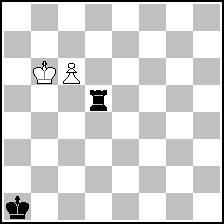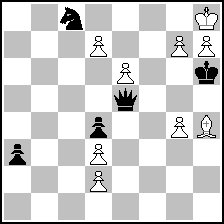
Website founded by
Milan Velimirović
in 2006
0:13 UTC


| |
MatPlus.Net  Forum Forum  Endgame studies Endgame studies  My favourite study My favourite study |
| |
|
|
|
|
You can only view this page!
| | | (1) Posted by Sarah Hornecker [Sunday, Sep 16, 2007 06:22] | My favourite study
 (= 2+2 ) (= 2+2 )
Georges Emile Barbier and Fernando Saavedra
Glasgow Weekly Citizen, 4th May 1895 / 18th May 1895 (version)
White to move and draw
This may be the most reprinted study ever. It was maybe the first study I saw, in a chess book for beginners, when I was six or seven years old. I even loved it without that famous story that is widely known by now, about Mr. Fenton, Mr. Potter, Mr. Barbier and Mr. Saavedra. And without the not so famous story about Mr. Porterfield Rynd.
I don't want to repeat it here. Maybe I'll never again write about this, too many men have done this before and I always cry with the emotions this story brings to me. It's very moving to think about a man whose only move he is known for made him immortal. The sheer luck he had. It is as if the puppet master - call him God if you're religious - wanted this precious diamond to appear and not only that, he wanted Saavedra to become known by all present and future generations.
Yes, I didn't want to start it but now...
it was 1875 when Mr. Fenton and Mr. Potter played an interesting game. In the end, Fenton had a won position but didn't realize it. Instead, he agreed to a draw. Only later it was discovered how white could have won. When Potter died 20 years later Barbier made a mistake. He wanted to reproduce the position, gave it wrong and published it. Later he discovered a stalemate when the black king is in the corner a1. So he published it as a draw with black to move (with Pc7 instead c6). In the week after publication, a spanish reverend solved the position but discovered something interesting: White could actually win. So he sent what he found to Barbier who published it again, this time with white winning. Only years later someone inserted 1.c7 to complete the study.
1.c7 Rd6+ 2.Kb5 Rd5+ 3.Kc4 Rd4+ 4.Kb3 Rd3+ 5.Kc2 Rd4!! 6.c8Q Rc4+! 7.Qxc4 stalemate
Thie is what Barbier had in mind but then Saavedra came and...
6.c8R!! Ra4 7.Kb3! threatening both 8.Rc1 mate and 8.Kxa4. Black is helpless.
A few months later Barbier went back to France and died there in December 1895. Saavedra never again did something interesting for chess. His contribution to this study was his only work for the chess world, but it was enough to make him immortal as long as chess exists.
Of course there are many studies with this motif today, some very spectacular and brillant. But - as Tim Krabbé said - the best Saavedra is Saavedra...
Today there are around 80,000 studies but this one still is the best of it all. There's no modern content in it, nothing worth mentioning except this rook promotion.
But it doesn't need it! It's brillant in it's simplicity! Only an emotional being really could understand what this study is. While a computer may show a mate in 26, it still may never understand anything else than it's numbers. It would not even understand the simplest problems. It may calculate solutions but not solve.
Okay, that's my favourite study (for my favourite problem, see the Yarosh #4). What's yours?
| | | (2) Posted by Zalmen Kornin [Tuesday, Sep 18, 2007 04:26] |
Actually if someone had to choose from 80.000 studies, he would probably be in front of huge question - he would trust perhaps in the statistics and select a first prize winner by a very prolific author (there's a sort of a rigid truth in the procedure, because in this way we could arrive to something quite trustable...) Sadly (or maybe - happily) when my best memories on an ideal Study were amalgamated we had no mega-base, not even '1234' or '1357', but just Chernev's '160' ("Chessboard Magic"), a selection of old EGs in which the names of Bron, Gorgiev, Gurevich, Herbstmann, Kasparian, Korolkov, Kubbel, Liburkin, Mattison. Simkhovich, Somov-Nasimovich and Troitski are the most represented - just around 70 of the 160 are not by one of them... Many classics, but - strangely - names like Réti or Saavedra are not mentionned at all - Well, it was the moment of the revelation of the 'Soviets'... Well, in short - one that remained indelibly in the memory from this selection of spectacular Studies is following, involving - of course - some underpromotions:
F. Richter
"Ceskoslovensky Sach" 1934
Mention
 (= 9+5 ) (= 9+5 )
= White to Play and Draw
| |
No more posts |
MatPlus.Net  Forum Forum  Endgame studies Endgame studies  My favourite study My favourite study |
|
|
|
 ISC 2024
ISC 2024 Forum
Forum  Endgame studies
Endgame studies  My favourite study
My favourite study 
